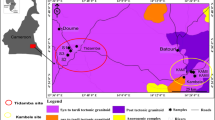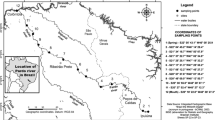Abstract
Water fountains are usually present in the urban public places and often draw the attention of citizens and tourists. Their water is often, in various ways, used by adults and children, but water from fountains is not usually a subject of researchers’ interest. This paper describes the analytical procedure and the results of the multi-elemental characterisation of the waters from the selected public water fountains in the city of Zagreb, Republic of Croatia. Twenty-eight chemical elements (Al, As, B, Ba, Be, Cd, Co, Cr, Cu, Fe, Li, Mn, Mo, Ni, P, Pb, S, Sb, Se, Sr, Ti, Tl, V, Zn and Ca, K, Mg and Na) were quantified by means of ICP-AES technique. In addition to the multi-elemental analysis, determination of pH values was performed too. Pearson’s correlation coefficients suggest that Al, Cu, Fe, Mn and Pb originate from the plumbing system and their leaching is strongly negatively correlated with the pH values of the tested samples. On the other hand, alkali and alkaline-earth metals as well as Mo, Ti, Zn and B, P and S are most probably of a natural origin in the water samples tested in this study. The results lead to the conclusions that (i) trace and major element content in squirt of a monumental water fountain is analogous to their content in water of the same origin and (ii) a pool of a fountain which is made of a high-quality stone, in the context of the herein performed testings, generally does not affect the quality of water which is contained in it.


Similar content being viewed by others
References
Calace N, Caliandro L, Petronio BM, Pietrantonio M, Pietroletti M, Trancalini V (2012) Distribution of Pb Cu Ni and Zn in urban soils in Rome city (Italy): effect of vehicles. Environ Chem 9:69–76
Campanella B, Onor M, D’Ulivo A, Giannecchini R, D’Orazio M, Petrini R, Bramanti E (2016) Human exposure to thallium through tap water: a study from Valdicastello Carducci and Pietrasanta (northern Tuscany Italy). Sci Total Environ 548–549:33–42
Ćavar S, Klapec T, Jurišić Grubešić R, Valek M (2005) High exposure to arsenic from drinking water at several localities in eastern Croatia. Sci Total Environ 339:277–282
Cech I, Smolensky MH, Afshar M, Broyles G, Barczyk M, Burau K, Emery R (2006) Lead and copper in drinking water fountains–information for physicians. South Med J 99:137–142
Clement M, Seux R, Rabarot S (2000) A practical model for estimating total lead intake from drinking water. Water Res 34:1533–1542
Çöl M, Çöl C (2003) Environmental boron contamination in waters of Hisarcik area in the Kutahya Province of Turkey. Food Chem Toxicol 41:1417–1420
Davydova S (2005) Heavy metals as toxicants in big cities. Microchem J 79:133–136
Di Giuseppe D (2017) Comparison of the mineral element content of public drinking fountains and bottled water: a case study of Ferrara city. Geosciences 7:76
Fiket Ž, Roje V, Mikac N, Kniewald G (2007) Determination of arsenic and other trace elements in bottled waters by high resolution inductively coupled plasma mass spectrometry. Croat Chem Acta 80:91–100
Fiket Ž, Rožmarić M, Krmpotić M, Benedik L (2015) Levels of major and trace elements including rare earth elements and 238U in Croatian tap waters. Environ Sci Pollut Res 22:6789–6799
Galvin RM (1996) Occurrence of metals in waters: an overview. Water SA 22:7–17
Giotakos O, Nisianakis P, Tsouvelas G, Giakalou V-V (2013) Lithium in the public water supply and suicide mortality in Greece. Biol Trace Elem Res 156:376–379
Habuda-Stanić M, Kuleš M (2002) Arsenic in drinking water. Kem Ind 51:337–342 (in Croatian, abstract in English)
Holbrook RD, Motabar D, Quiñones O, Stanford B, Vanderford B, Moss D (2013) Titanium distribution in swimming pool water is dominated by dissolved species. Environ Pollut 181:68–74
Huber M, Welker A, Helmreich B (2016) Critical review of heavy metal pollution of traffic area runoff: occurrence influencing factors and partitioning. Sci Total Environ 541:895–919
Hwang H-M, Fiala MJ, Park D, Wade TL (2016) Review of pollutants in urban road dust and stormwater runoff: part 1. Heavy metals released form vehicles. Internat J Urban Sci 20:334–360
Kabacs N, Memon A, Obinwa T, Stochl J, Perez J (2011) Lithium in drinking water and suicide rates across the East of England. Br J Psychiatry 198:406–407
Kaim W, Schwederski B (1994a) Bioinorganic chemistry: inorganic elements in the chemistry of life (an introduction and guide). J. Wiley & Sons, Chichester, pp 39–55
Kaim W, Schwederski B (1994b) op. cit. pp. 330–350
Krmpotić M, Rožmarić M, Petrinec B, Bituh T, Fiket Ž, Benedik L (2018) Radionuclide and major element analysis of thermal and mineral waters in Croatia with related dose assessment. Radiat Prot Dosimetry 181:199–207
Narodne novine (2008) Regulations on health safety of drinking water. Narodne novine (The Official Gazette of the Republic of Croatia) 47/2008:1593
Ohgami H, Terao T, Shiotsuki I, Ishii N, Iwata N (2009) Lithium levels in drinking water and risk of suicide. Br J Psychiatry 194:464–465
Ottesen RT, Langedal M (2001) Urban geochemistry in Trondheim. Norway NGU-Bulletin 438:63–69
Pizent A, Butković S (2010) Copper in household drinking water in the city of Zagreb Croatia. Arhiv za Higijenu Rada i Toksikologiju − Archives of Industrial Hygiene and. Toxicology 61:305–309
Pompili M, Vichi M, Dinelli E, Pycha R, Valera P, Albanese S, Lima A, De Vivo B, Cicchella D, Fiorillo A, Amore M, Girardi P, Baldessarini RJ (2015) Relationships of local lithium concentrations in drinking water to regional suicide rates in Italy. World J Biol Psychiatry 16:567–574
Regunathan PR (2009) Water production technical issues and economics in: calcium and magnesium in drinking-water − public health significance. World Health Organization, Geneve, pp 154–165
Roje V, Orešković M, Rončević J, Bakšić D, Pernar N, Perković I (2018) Assessment of the trace element distribution in soils in the parks of the city of Zagreb (Croatia). Environ Monit Assess 190:121
Sehar S, Naz I, Ali N, Ahmed S (2013) Analysis of elemental concentration using ICP-AES and pathogen indicator in drinking water of Qasim Abad District Rawalpindi Pakistan. Environ Monit Assess 185:1129–1135
Šoljić Z (1998) Calculations in analytical chemistry (in Croatian). University of Zagreb − Faculty of Chemical Engineering and Technology, Zagreb
Stechmann H, Dannecker W (1990) Characterization and source analysis of vehicle-generated aerosols. J Aerosol Sci 21:S287–S290
Sullivan PJ, Agardy FA, Clark JJJ (2005) The environmental science of drinking water, 1st edn. Elsevier Butterworth-Heinemann, Burlington
TIBCO Software Inc. (2017) Statistica (data analysis software system) version 13, http://statistica.io
Tropan L, Karleuša R (2009) Fountains – with a special focus on the city of Zagreb (in Croatian). Hrvatske Vode 17:145–156
Vaessen HAMG, Szteke B (2000) Beryllium in food and drinking water − a summary of available knowledge. Food Addit Contam 17:149–159
WHO (2017) Guidelines for Drinking-water Quality − Fourth edition incorporating the first addendum. World Health Organization, Geneve
Zietz BP, Richter K, Laß J, Suchenwirth R, Huppmann R (2015) Release of metals from different sections of domestic drinking water installations. Water Qual Expo Health 7:193–204
Acknowledgment
The authors would like to thank Mrs. Biserka Petošić from the City Office for Agriculture and Forestry and the Mayor of Zagreb Mr. Milan Bandić.
Funding
The functioning of the Laboratory for Ecology and Pedology at Faculty of Forestry, University of Zagreb, where this research has been conducted, was partially financially supported by the Zagreb Municipal Administration.
Author information
Authors and Affiliations
Corresponding author
Ethics declarations
Conflict of interest
The authors declare that they have no conflict of interest.
Additional information
Responsible editor: Philippe Garrigues
Rights and permissions
About this article
Cite this article
Roje, V., Dukić, J. & Šutalo, P. The first example of multi-elemental analysis of water samples from urban monumental fountains—a case study from Zagreb (Croatia) . Environ Sci Pollut Res 26, 2635–2648 (2019). https://doi.org/10.1007/s11356-018-3809-x
Received:
Accepted:
Published:
Issue Date:
DOI: https://doi.org/10.1007/s11356-018-3809-x




